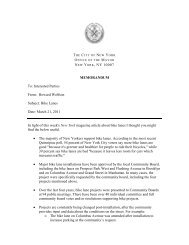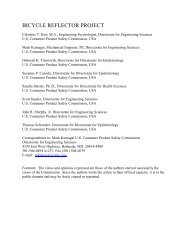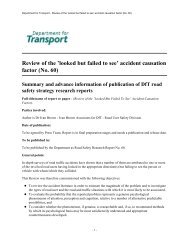Guide for the Development of Bicycle Facilities - The Industrialized ...
Guide for the Development of Bicycle Facilities - The Industrialized ...
Guide for the Development of Bicycle Facilities - The Industrialized ...
You also want an ePaper? Increase the reach of your titles
YUMPU automatically turns print PDFs into web optimized ePapers that Google loves.
guide <strong>for</strong> development <strong>of</strong> bicycle facilities 39<br />
However, when a lean angle <strong>of</strong> 20 o is used, more horizontal space will<br />
be taken up by <strong>the</strong> bicyclist taking <strong>the</strong> curve and more width needs to be<br />
provided. In <strong>the</strong>se cases <strong>the</strong> pathway width should be increased and a<br />
center line placed down <strong>the</strong> middle <strong>of</strong> <strong>the</strong> path.<br />
When curve radii smaller than those shown in Table 2 must be used because<br />
<strong>of</strong> limited right-<strong>of</strong>-way, topographical features or o<strong>the</strong>r<br />
considerations, standard curve warning signs and supplemental pavement<br />
markings should be installed in accordance with <strong>the</strong> MUTCD 2 .<br />
<strong>The</strong> negative effects <strong>of</strong> sharper curves can also be partially <strong>of</strong>fset by widening<br />
<strong>the</strong> pavement through <strong>the</strong> curves.<br />
Grade<br />
Grades on shared use paths should be kept to a minimum, especially on<br />
long inclines. Grades greater than 5 percent are undesirable because <strong>the</strong><br />
ascents are difficult <strong>for</strong> many bicyclists to climb and <strong>the</strong> descents cause<br />
some bicyclists to exceed <strong>the</strong> speeds at which <strong>the</strong>y are competent or<br />
com<strong>for</strong>table. On some shared use paths, where terrain dictates, designers<br />
may need to exceed <strong>the</strong> 5 percent grade recommended <strong>for</strong> bicycles<br />
<strong>for</strong> some short sections. As a general guide, <strong>the</strong> following grade restrictions<br />
and grade lengths are suggested:*<br />
5-6% <strong>for</strong> up to 240 m (800 ft)<br />
7% <strong>for</strong> up to 120 m (400 ft)<br />
8% <strong>for</strong> up to 90 m (300 ft)<br />
9% <strong>for</strong> up to 60 m (200 ft)<br />
10% <strong>for</strong> up to 30 m (100 ft)<br />
11+% <strong>for</strong> up to 15 m (50 ft)<br />
Grades steeper than 3 percent may not be practical <strong>for</strong> shared use paths<br />
with crushed stone or o<strong>the</strong>r unpaved surfaces <strong>for</strong> both handling and<br />
drainage erosion reasons.<br />
Options to mitigate excessive grades:<br />
❍ When using a longer grade, an additional 1.2-1.8 m (4-6 feet) <strong>of</strong><br />
width to permit slower speed bicyclists to dismount and walk may<br />
be considered.<br />
❍ Provide signing that alerts bicyclists to <strong>the</strong> maximum percent <strong>of</strong><br />
grade (MUTCD 2 ).<br />
❍ Provide recommended descent speed signing.<br />
❍ Exceed minimum stopping sight distances.<br />
❍ Exceed minimum horizontal clearances, recovery area and/or protective<br />
bike rails.<br />
*See Chapter 2—O<strong>the</strong>r Design Considerations, Accessibility Requirements, p. 69.<br />
Design<br />
Shared Use Paths





